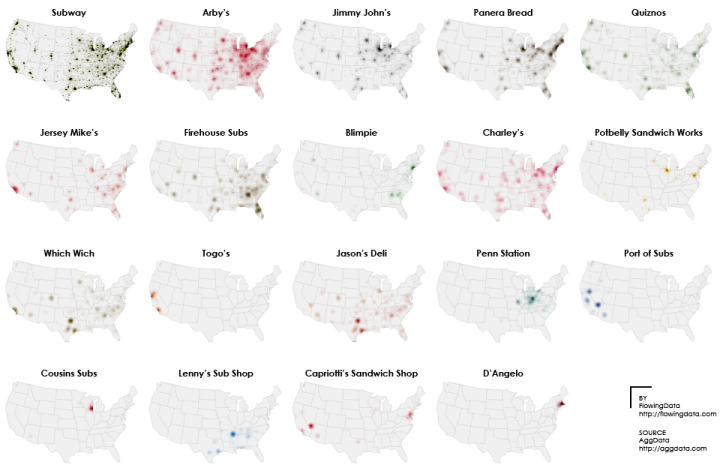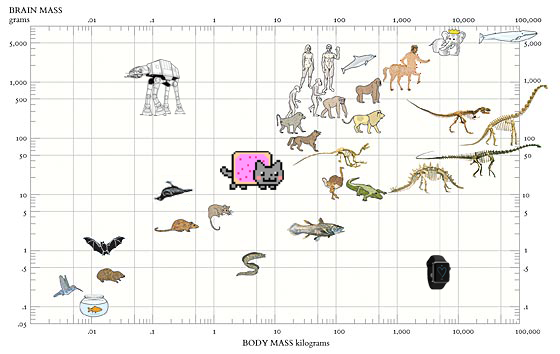As in, you data me, I data you, and they data us. Jer Thorp argues for a verbified data, because after all, it’s already in a grammatical shift with the whole big data thing. Just take it a step further already.
Read More
-
-
Fathom provides an interactive browser for a year of earthquakes, based on data from USGS. You’ve likely seen this data before, but the interaction is quite useful and applicable to other maps.
Filters on the right let you turn layers — population density, mortality risk, and the tectonic plates lines — on and off and subset by magnitude. The timeline on the bottom lets you scrub by time with an adjustable time span.
-
There’s been a sudden bump in grid maps lately taking the place of state choropleths. For example, Haeyoun Park used them to show changes in state laws for gay marriage. The advantage over the choropleth is that each state gets equal visual space, and the placement still lets people find specific states and interpret geographic relationships.
The grid format is pretty much universally liked, but now we must ask what shape is best? NPR tried the grid with hexagons. Danny DeBelius explains the reasoning, and the grid map landscape may never be the same again.
But you know what? Forget all that.
Read More -
When you walk down the aisles of the grocery store, there are probably shelves of organic foods with branding that looks small, local, and healthy. It’s almost like you’re buying products direct from the farmer. But probably not. The Washington Post highlights the ownership, based on work by Phil Howard, who has looked at similar ownership networks with beer, wine, and soda in years past.
Read More -
Wyoming just passed a law that makes it illegal to collect data about the environment, if you intend to send it to a federal or state government agency.
The reason? The state wants to conceal the fact that many of its streams are contaminated by E. coli bacteria, strains of which can cause serious health problems, even death. A small organization called Western Watersheds Project (which I represent pro bono in an unrelated lawsuit) has found the bacteria in a number of streams crossing federal land in concentrations that violate water quality standards under the federal Clean Water Act. Rather than engaging in an honest public debate about the cause or extent of the problem, Wyoming prefers to pretend the problem doesn’t exist. And under the new law, the state threatens anyone who would challenge that belief by producing information to the contrary with a term in jail.
Um, wut?
The intent part confuses me most. So is it okay to collect environmental data that you don’t plan on sending to a government agency? If I were in Wyoming, I’d grab the nearest water kit, collect data water data like a fiend, and send it to my local paper, news outlet, or anywhere else that could publicize high concentrations of E. coli.
-
There were some blips on Twitter last week for the DrunkTufte hashtag for which people made some not so readable charts. I’m really hoping it becomes a thing. The entry below is by Matt Fogel. Makes sense to me.
-
Virginia Eubanks for Slate describes the dangers of relying too heavily on black-boxed algorithms to create and enforce policies.
Policy algorithms promise increased efficiency, consistent application of rules, timelier decisions, and improved communication. But they also raise issues of equity and fairness, challenge existing due process rules, and can threaten Americans’ well-being. Predictive policing relies on data built upon a foundation of historical racial inequities in law enforcement. Remote eligibility systems run on the questionable assumption that lacking a single document—in a process that often requires dozens of pages of supporting material—is an affirmative refusal to cooperate with the welfare determination process.
-
For a while, somewhere in between 2007 and 2011, infographics — in the everyday person’s sense, not the statistician’s — were all the rage. They came in lots of shapes and sizes and covered a wide span of useful to useless topics. While these sort of graphics are still around, they’re dwarfed by a different brand of work these days. A more mature one.
Mark Wilson for FastCompany describes the evolution. (Disregard the “What Killed The Infographic?” title of the article. Spammy embedded infographics are slowly dying, but the good stuff is a young whippersnapper discovering its powers.)
Read More -
Eric Benson for FiveThirtyEight delves into cattle theft, which can cost an owner millions of dollars overnight, and the link to rising beef prices.
Most cuts of beef increased in cost since 1995, but brisket, while still not the most expensive cut, has really increased in value in the past couple of years. It peaked in January 2015 at $3.52 per pound wholesale. It was only $2.26 in January 2014. That’s kind of big deal considering you’re buying a 10-pound piece of meat at the grocery store, versus a couple of pounds of steak.
-
An analysis by Raj Chetty of Harvard University and Nathaniel Hendren of NBER estimates increased income and education for poverty-level households, based on where one lives. The results are based on tax data — 1040 and W-2 forms — from the IRS, and the focus of the analysis is on those who moved from one county to another.
The main finding was that location matters. The Upshot mapped the results, with an article whose text changes based on the county you select.
Read More -
-
A Course for Visualization in R, Taking You From Beginner to Advanced
Where to start? What to learn next? Here’s a course to help take you from beginner to advanced.
-
There’s a lot of data readily available online. We know this. However, there’s also a lot of data available that’s offline, sitting on people’s hard drives. You just have to ask for it — in the right way. Christian Kreibich, a researcher for the International Computer Science Institute, provides a guide.
Read More -
The Economist made a simple yet effective comparison of Black America and White America against metrics of countries that are part of the Human Development Index and the OECD. In incarcerations and homicides, you see Black America (red line) at and towards the bottom.
Read More -
Select one or more races for a quick comparison. Counties are colored by the most prevalent.
-
Dominik Schwarz wanted a big world map. A really big one that covered his entire wall in high detail.
You can get great world maps up to around 1,50m (~59 inches) width. However, this size seems to be a tipping point. From here on the bigger the maps get, the less detailed they are. And it makes sense. Such big maps are normally used in classrooms and even the people in the last row should see the large printed city names.
But that’s not what I wanted. Not at all. I envisioned a gigantic poster that would show the smallest villages, the most detailed coast lines and the highest level of information density possible.
He outlined his process from grabbing the data to printing to final mount.
-
The median home in America has changed in a variety of ways. Square footage increased, number of bedrooms and bathrooms shifted, heating changed from electrical to gas, and cost went up. CNNMoney provides an animated graphic that shows these changes over the past four decades.
Read More -
The earthquake in Nepal was big, but there’s a discrepancy in just how big. The United States Geological Survey (USGS) measured the earthquake at 7.8 magnitude, whereas the China Earthquakes Network Center (CENC) measured it at 8.1. The three-tenths difference doesn’t seem like much, but the latter is actually an earthquake that exerts twice the energy of the former. Akshat Rathi and David Yanofsky for Quartz explain in a lesson of the logarithmic scale and earthquake magnitude.
-
Fashion trends, such as skinny jeans and Palazzo pants, can spike and fall quickly year over year, and it can be tough to keep up. Maybe trends in Google searches for specific fashions can help. Hiroko Tabuchi and Josh Katz for the New York Times mapped a handful of fashion searches over time so you can see some of the regional changes.
Read More








 Visualize This: The FlowingData Guide to Design, Visualization, and Statistics (2nd Edition)
Visualize This: The FlowingData Guide to Design, Visualization, and Statistics (2nd Edition)










